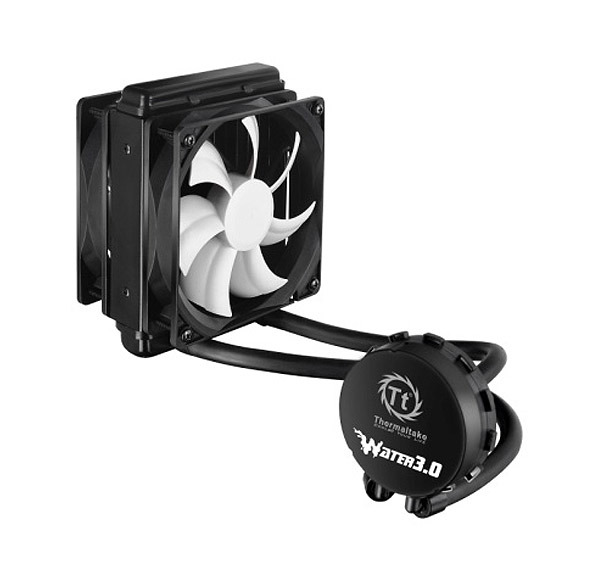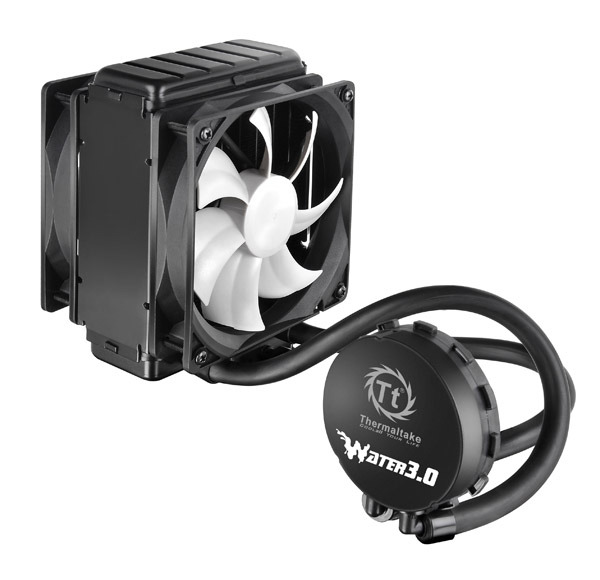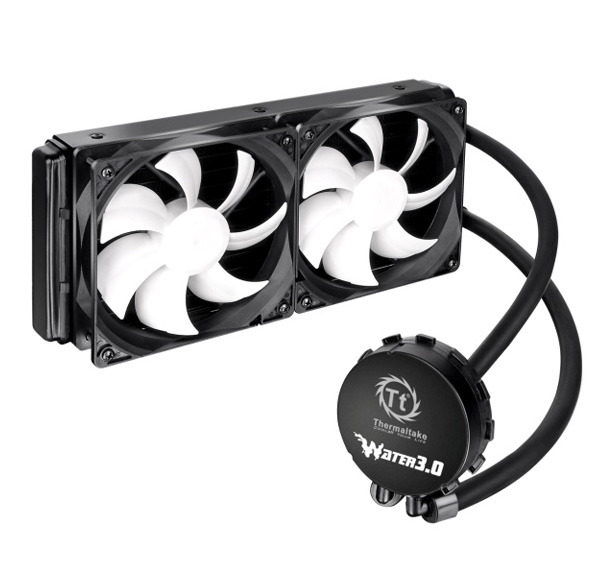Thermaltake Debuts Water 3.0 Closed-Loop Water Coolers
Thermaltake has announced an update to its lineup of water coolers.
The closed loop water cooling market is a bit diluted to say the least, but there is now a new contender. Thermaltake, who already has some experience making closed loop water cooling kits, has released its new version of its Water-series coolers. The previous Water 2.0 models were already welcomed with warm hands into the market, and now Thermaltake has released its new revision, the Water 3.0. The Water 3.0 water cooling kits will come in three versions: the Water 3.0 Extreme, the Water 3.0 PRO, and the Water 3.0 Performer.
The Water 3.0 Performer is the entry level water cooler. It has a simple thin 120 mm radiator and two fans. Due to this, it should fit in almost any enclosure.
The Water 3.0 PRO has a 120 mm radiator, but one that is much thicker at 49 mm. It is almost twice as thick as the Water 3.0 Performer. The purpose of it is to have good performance. It ships with two fans out of the box.
The Water 3.0 Extreme packs a 240 mm radiator, which comes with two fans, although four fans can be equipped. It is targeted at users who want the best performance and have a roomy enclosure.
Get Tom's Hardware's best news and in-depth reviews, straight to your inbox.
Niels Broekhuijsen is a Contributing Writer for Tom's Hardware US. He reviews cases, water cooling and pc builds.
-
Ninjamonkeh I'm confused, never had a water cooler but isnt the whole point to water is not to have all the fan noise? Perhaps im wrong and its only if you want to overclock.Reply -
funguseater Ninja, the other purpose is to remove the heat from your enclosure, instead of blowing it around inside the case.Reply
Have Fun -
thundervore So Thermaltake finally paid Asetek enough money to rebrand their product?Reply
What is the point of going for this now, unless they redesigned the CPU block to get cooler temperatures its no better than the rest of Asetek AIO coolers that everyone else rebrands.
Performer = Corsair H60 refresh = Zalman LQ 310.
Pro = Antec 920 = Zalman LQ320
Extreme = H100.
All made by Asetek then rebranded. When will these companies learn that unless you make a 49mm thick 240 rad to be different, everyone is just going to choose their favourite brand and buy it. Corsair is usually first to the market then everyone else follows.
In 3 months there will be article about Antec new 2013 water coolers which will be the same rebranded Asetek stuff!
-
Unolocogringo Reply10727225 said:Ninja, the other purpose is to remove the heat from your enclosure, instead of blowing it around inside the case.
Have Fun
Corsairs newest systems advise you to mount the system on the back exhaust fan placement. But to have it blowing into the case not exhaust.
Which totally negates you answer for noobie builders who will read the manual and install it according to directions.
I have 2 120mm quiet rear fans and 2 120mm quiet top fans. With the 212 EVO in push pull, there is no way the heat from my cpu will ever get recirculated in my case.
With 1 120mm and 1 200mm front intake and a 140mm side intake heat is not a problem.
The most noise and heat from my case is the 2 GTX 460s.
-
thundervore Reply10727225 said:Ninja, the other purpose is to remove the heat from your enclosure, instead of blowing it around inside the case.
Have Fun
Not exactly. As long as your case have positive air pressure the hot air will not stay inside your case. The purpose of water cooling is to keep your load temps lower without the added fan noise.
Most users will install the AIO coolers pulling in cooler air from the outside the case and blowing hot air inside the case. But as long as you have positive pressure the hot air will not stay in your case or recirculate. Having positive pressure also helps eliminate dust build up if all intake fans have filters. -
laststop311 I find the 140mm radiator size and fans to be much superior to even a dual 120 240mm rad. A thick 140mm and push pull 140mm fans can run at a lower speed and provide equal cooling to a 120mm or you can kick the speed up and get equal performance to a 240mm rad with 2 fans in push only. Most cases can support 140mm on the rear top exhaust so it really is the optimal solution. 140mm fans can be much quieter since you can run them slower as well.Reply -
Marcus52 Reply10727165 said:I'm confused, never had a water cooler but isnt the whole point to water is not to have all the fan noise? Perhaps im wrong and its only if you want to overclock.
Water cooling rigs (good ones, anyway) tend to be quieter only at peak overclock levels, when the cooler is driven to run at its hardest. There was some early attempt to claim a water cool system would be quieter - nut unless it allowed you to get rid of a fan or use it at a lower speed, that really doesn't make a lot of sense, because the radiator needs a fan (or fans), too.
The advantages of water cooling are space around the CPU is much better, the height of the water block/pump assembly is much lower than high-end air coolers so you can use it in cases where height is an issue (assuming you can figure out what to do with the radiator), weight on the mainboard is significantly less, and overclocking limits are higher (better) with the best water-cooling solutions.



